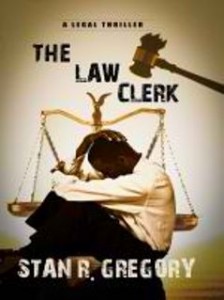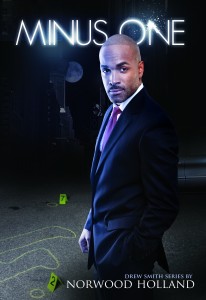The Law Clerk by Stan R. Gregory
March 31, 2012
Stan Gregory’s first novel The Law Clerk is the story of Ben, a hard working judicial clerk not long out of law school enjoying his job but struggling to make ends meet. Ben is like a grounded caterpillar trudging along until the transformation to fly. Just when it seems fate has provided the right romance comes along an opportunity to get out of all his burdensome debt. Unsatisfied in his grounded state he attempts to speed up the process to fly to financial freedom. That opportunity presents itself in the form of a moral choice between right and wrong. Ben must decide whether to take a bribe and steal privileged documents from the Evidence Room for a rogue felon with a history of stock manipulation.
The temptation is too great. He succumbs to the dilemma gambling his future and license for immediate financial security. Ben sells his soul hoping it’s done but knowing it’s not over. As usual in cases of bribery blackmail follows and Ben is pressured to steal more documents. So how does Ben make it all right and reclaim his integrity? He begins by using the money to hire a private eye to track down and disclose the source of his new misery.
The Law Clerk is chocked with suspenseful action. It’s well written with organic metaphors and subtle classical allusions and an adequate sprinkling of romance. It’s a real legal thriller. Too often a new novel is touted as a legal thriller only to discover the thrill is gone. As promised Gregory delivers gripping suspense. Writers are often advised to make the protagonist suffer with the challenge of overcoming that suffering. The theme of temptation and its consequences makes the reader uncomfortable siding with Ben’s conscience warning him not to do it, but he does and thus becomes a lawyer without principle. And that just won’t do for a hero. Butterflies are free, but not in your stomach. So how does he make it right and what is the lesson learned?
I won’t spoil the ending with too much detail, but I recommend The Law Clerk with five stars.
Self Publishing: Designing The Book Cover
March 19, 2012
 They say you can’t judge a book by its cover. All the more reason when marketing a book it should present the best possible first impression. The cover should summarily tell a potential reader what the book is all about both figuratively and literally. A picture is worth a thousand words, and your cover should charm and seduce a reader into wanting to spend time under its spell for some 90,000 plus words. Romance authors have relied on this art form with bare chested hunks with glistening abs and bulging pecs embracing the ripped bodice of a voluptuous female. Cheesy maybe, but sex sells, and though you may not be selling sex the idea is to entice a potential reader to pick up your book, thumb through it, and to read the back and front material. Intrigue them and make the book impossible to walk away from purchasing. This can be accomplished with an image coupled with blurbs.
They say you can’t judge a book by its cover. All the more reason when marketing a book it should present the best possible first impression. The cover should summarily tell a potential reader what the book is all about both figuratively and literally. A picture is worth a thousand words, and your cover should charm and seduce a reader into wanting to spend time under its spell for some 90,000 plus words. Romance authors have relied on this art form with bare chested hunks with glistening abs and bulging pecs embracing the ripped bodice of a voluptuous female. Cheesy maybe, but sex sells, and though you may not be selling sex the idea is to entice a potential reader to pick up your book, thumb through it, and to read the back and front material. Intrigue them and make the book impossible to walk away from purchasing. This can be accomplished with an image coupled with blurbs.
Novel covers are generally influenced by the overall tone of the book. In planning a cover decide whether to use a graphic or photographic representation. I write in the noir mystery thriller genre which relies on heavy realism therefore I decided to go with the photographic while a fantasy genre author would prefer an animated still image. The next step is finding a graphic artist and/or photographer who can translate your ideas into a captivating image. I found my graphic artist when I noticed a Facebook friend’s book cover. Immediately after a brief introduction we were in simpatico. I now rely on that artist for all covers and promotional art work. It’s important to find a graphic artist who’s work you admire and with whom you can connect.
It can’t be emphasized enough the importance of working with a professional. BookSlut blogger Jessa Crispin in her feature How to Judge A Book by its Cover tells what she looks for when browsing for a book to purchase and its all in the cover. Her subjective assessment tells what she seeks and avoids in evaluating a cover’s components including the artwork, the spine, descriptions, back and front panels, fonts, blurbs. the author photo and the ISBN block. A good exercise is to browse bookstore shelves to get ideas. Unless you’re an accomplished writer and artist I would not attempt to design my own cover, but if you have supreme confidence in your artistic ability then by all means go with it. Read the link to Anthony P. Palmieri’s Designing a Cover for your Book: A Guide for Self Publishers, in addition , the internet offers a number of how to articles and videos. See How To Design Book Covers.
If your book is a work of art then so should be your cover. It may be the rule you can’t judge a book by its cover, but it’s the exception that proves the rule: a great book cover is usually an indication of a great book. Both require time and careful attention.
Print vs. EBook
February 23, 2012
 There is much speculation about the future of the printed book format; however, rumors of the death of the traditional business model have been greatly exaggerated. An author considering self-publishing may wonder whether to initially publish in print or eReader format. While going digitally may be the most economical obviously you want to consider both to reach a maximum readership. Amazon eBook sales now exceed hardcover sales by a ratio of 1.43, and many of those sales are on the low end with downloads ranging from 25 to 99 cents. The New York Times reports half of the books on its best seller list are given away for free on Kindle. While eBooks publishing is a new frontier growing in increasing popularity the traditional format if far from extinct. There are still minions of readers who will resist the eReader craze choosing to stick with traditional books and bookstores.
There is much speculation about the future of the printed book format; however, rumors of the death of the traditional business model have been greatly exaggerated. An author considering self-publishing may wonder whether to initially publish in print or eReader format. While going digitally may be the most economical obviously you want to consider both to reach a maximum readership. Amazon eBook sales now exceed hardcover sales by a ratio of 1.43, and many of those sales are on the low end with downloads ranging from 25 to 99 cents. The New York Times reports half of the books on its best seller list are given away for free on Kindle. While eBooks publishing is a new frontier growing in increasing popularity the traditional format if far from extinct. There are still minions of readers who will resist the eReader craze choosing to stick with traditional books and bookstores.
Publishing is a resilient industry adapting to the new challenges of the 21st Century. It will not only survive the digital age but thrive. There are new evolving best sellers’ lists catering to eBooks alone like the The Kindle Best Seller List and both the Wall Street Journal and USAToday have revamped their book coverage with eBook best seller lists presenting publishers with new challenges. New book promotions no longer exclusively rely on securing media attention and popular print reviews. The internet has opened up a whole new world for book promoters.
New cheaper opportunities in eBook marketing rely on book blogs, book blog tours, book clubs, and online magazine reviewers. That’s not to say you should forego the print marketing business model. In fact, meeting and mingling with your readers with book store signings and library and book club readings remain the best way to build a readership — word of mouth is the best form of advertising. The independent publisher’s challenge is to create buzz around a new book.
Depending on preferences, some authors avoid public events while others thrive on the live audience. The internet offers the best of both worlds in reaching a real and virtual audience. The publishing industry has a history of meeting and overcoming challenges. Past threats include the flood of the cut rate dime store paperbacks, as well as the growth of lending libraries and book clubs selling inexpensive hardbacks. The challenges met with industry resistance and the industry managed to adapt and make the best of it meeting consumer demand. EBooks are yet another challenge.
The best writers take an active, entrepreneurial role in their book sales. Publishing is filled with success stories that began as self-publishing miracles. The independent publisher’s challenge is to mine the electronic frontier finding new ways to sell and market both print and eBooks.
Organizing the publishing entity
February 17, 2012
![]() Once you’ve written your masterpiece, and either hired an editor or used beta readers to perfect the manuscript, what’s next? If this is your first foray into self-publishing you should first determine how you plan to operate and establish your business structure. In considering what type of independent publisher you want to be, seek legal counsel, preferably an expert in literary matters. A good place to begin is with your local Small Business Administration, also often local college business schools offer clinics and assistance for fledgling entrepreneurs. Selecting a business entity is one of the most important decisions a business owner can make. Choosing the most favorable business structure will affect the protection of personal assets, taxation and a smooth continuation of the business upon change in ownership. There are three types of business structures to consider.
Once you’ve written your masterpiece, and either hired an editor or used beta readers to perfect the manuscript, what’s next? If this is your first foray into self-publishing you should first determine how you plan to operate and establish your business structure. In considering what type of independent publisher you want to be, seek legal counsel, preferably an expert in literary matters. A good place to begin is with your local Small Business Administration, also often local college business schools offer clinics and assistance for fledgling entrepreneurs. Selecting a business entity is one of the most important decisions a business owner can make. Choosing the most favorable business structure will affect the protection of personal assets, taxation and a smooth continuation of the business upon change in ownership. There are three types of business structures to consider.
Sole Proprietorship is usually the form in which most self publishers begin. The sole proprietor operates and controls his publishing venture alone. Profits and losses are considered part of your personal income. Funds can easily be transferred between personal and business accounts. Most entrepreneurs operate as sole proprietorships, but if your business takes off with let’s say an eBook with a millions in sales profit you might want to reconsider this business structure. Sole proprietors may have to depend on the owner’s personal credit rating to obtain business loans. In other instances, sole proprietors may end up using their personal savings to finance their business. If the individual owner of a sole proprietorship incurs any liability in the course of doing business, the creditors can look for recovery against the owner’s individual assets, such as a house or savings account. As your business grows and you take on more risk you might want to consider another structure.
Partnerships may be appropriate where friends, relatives, or a financial backers join in a venture and it becomes necessary to share in the profits and the losses. There are several types of partnerships, General, Limited, and Limited Liability. A general partnership is defined as the association of two or more persons to carry on as co-owners as a business for profit. Partners generally share control, gross returns, and property. Partners in a general partnership are jointly and severally liable for all the obligations arising from any wrongful act or omissions. Partnership like all relationships can get complicated and messy. A partnership agreement anticipates addressing possible disagreements and as such should be drafted by an attorney establishing the rights and liabilities of each partner. Partners have been known to overstep their prescribed boundaries in the ordinary course of business sometime incurring debts and liabilities without disclosure to the other partners. Partnerships can sometimes sour, and its best to choose a partner you can trust and knowing where you stand in a dissolution.
Corporations like partnerships come in different forms. Operating as a corporation offers protection to the directors, shareholders, and employees. As your business grows it would be in your best interest to transition into a corporation. Anyone dealing with a corporation and has a complaint against the business entity, be it from a contract or other losses, recovery is limited to whatever business assets exist. It insulates the principals, directors, employees and shareholders from personal liability. There are various forms of corporations which are distinguished by tax liability. Whether you adopt to operate as a Limited Liability Company or a Subchapter S Corporation there are related matters which should be explored with an attorney. Corporations are charge with more regulatory obligations.
There are numerous important issues to be considered in building a publishing business including licensing, regulations, the treatment of inventory, leases, contracts with vendors or customers, tax filings, intellectual property protection and employee issues. An attorney will aid in developing and reviewing your future business plans.
A Review of Ebony the Beloved by Hannah Spivey
February 13, 2012
 This is a story of the worst kind of childhood. Ebony while growing up in a dysfunctional household suffers physical and verbal abuse by her parents. Reduced to a pathetic creature she suffers similar abuse in school. A school official discovers her plight and rescues Ebony taking her into a caring home. One would think Ebony would be humbled and grateful finally being showered with love and attentive care. But poor Ebony can’t seem to handle her new life. Having been deprived of a healthy family relationship with low self esteem her carnal desires leads her back into trouble. It seems being deprived of the normal joys of growing up the teenager develops a fast feisty and frisky attitude. She’s wears stylish clothes, gets a perm, and discovers lipstick and jewelry. Suddenly inexperienced in life she thinks she grown.
This is a story of the worst kind of childhood. Ebony while growing up in a dysfunctional household suffers physical and verbal abuse by her parents. Reduced to a pathetic creature she suffers similar abuse in school. A school official discovers her plight and rescues Ebony taking her into a caring home. One would think Ebony would be humbled and grateful finally being showered with love and attentive care. But poor Ebony can’t seem to handle her new life. Having been deprived of a healthy family relationship with low self esteem her carnal desires leads her back into trouble. It seems being deprived of the normal joys of growing up the teenager develops a fast feisty and frisky attitude. She’s wears stylish clothes, gets a perm, and discovers lipstick and jewelry. Suddenly inexperienced in life she thinks she grown.
Ebony rejects the warming advice of her care taker and becomes involved with an older man. A wealthy pop star, Desmond is handsome and charming with a South Beach mansion. He sweeps the young girl off her feet and into his inescapable clutches. Desmond proves not to be the man she thought. Oblivious to reasons why an older man would be interested in an under age girl she believes it’s only natural because of her desirable beauty. After a series of clandestine meetings Ebony finds herself snagged in another dysfunctional relationship. Held against her will she’s reduced to a sex slave.
The story has an interesting twist at first you feel sympathy for poor Ebony, but that sympathy is quickly lost as the story advances. Initially Ebony is a victim of her circumstances of which she had no control, but when her physical appearance improves that downtrodden beaten lack of self esteem takes an about face. When Ebony is left to her own devices she becomes a victim of her own making. But there is growth, the beaten down trodden girl finally finds the wherewithal to fight back. Suddenly she reaches the tipping point transformed with a new found strength no longer willing to take the abuse she had long suffered from her parents and others.
Ebony the Beloved is an interesting read which at times forces the reader to suspend belief although stories of sex slaves and abuse are by there very nature despicable and unbelievable. At times preachy it took me awhile to grow into the story I believe because the author failed to adhere to the cardinal rule of fiction i.e. show don’t tell, nevertheless, overall the novel comes to a satisfying conclusion. 4 stars





